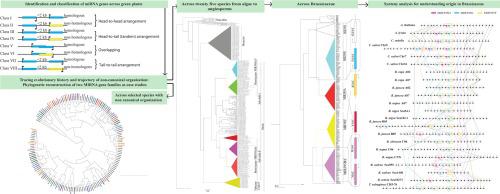当前位置:
X-MOL 学术
›
Plant Sci.
›
论文详情
Our official English website, www.x-mol.net, welcomes your
feedback! (Note: you will need to create a separate account there.)
Independent recurrent evolution of MICRORNA genes converging onto similar non-canonical organisation across green plant lineages is driven by local and segmental duplication events in species, family and lineages
Plant Science ( IF 4.2 ) Pub Date : 2020-12-01 , DOI: 10.1016/j.plantsci.2020.110661 Ekta Bhardwaj , Mukund Lal , S Anand , Sandip Das
Plant Science ( IF 4.2 ) Pub Date : 2020-12-01 , DOI: 10.1016/j.plantsci.2020.110661 Ekta Bhardwaj , Mukund Lal , S Anand , Sandip Das

|
The relationship between evolutionary history, organisation and transcriptional regulation of genes are intrinsically linked. These have been well studied in canonically organised protein-coding genes but not of MIRNAs. In the present study, we investigated the non-canonical arrangement of MIRNAs across taxonomic boundaries from algae to angiosperms employing a combination of genome organization, phylogeny and synteny. We retrieved the complete dataset of MIRNA from twenty-five species to identify and classify based on organisational patterns. The median size of cluster was between 2-5 kb and between 1-20 % of all MIRNAs are organized in head-to-head (with bidirectional promoter), head-to-tail (tandem), and overlapping manner. Although majority of the clusters are composed of MIRNA homologs, 25% of all clusters comprises of non-homologous genes with a potential of generating functional and regulatory complexity. A comparison of phylogeny and organizational patterns revealed that multiple independent events, some of which are species-specific, and some ancient, in different lineages, are responsible for non-canonical organization. Detailed investigation of MIR395 family across the plants revealed a complex origin of non-canonical arrangement through ancient and recent, segmental and local duplications; analysis of MIR399 family revealed major expansion occurred prior to monocot-dicot split, with few lineage-specific events. Evolution of "convergent" organization pattern of non-canonical arrangement originating from independent loci through recurrent event highlights our poor understanding of evolutionary process of MIRNA genes. The present investigation thus paves way for comparative functional genomics to understand the role of non-canonical organization on transcriptional regulation and regulatory diversity in MIRNA gene families.
中文翻译:

MICRORNA 基因的独立循环进化在绿色植物谱系中会聚到类似的非规范组织上是由物种、家族和谱系中的局部和节段复制事件驱动的
基因的进化历史、组织和转录调控之间的关系具有内在联系。这些已经在规范组织的蛋白质编码基因中得到了很好的研究,但在 MIRNA 中没有得到很好的研究。在本研究中,我们结合基因组组织、系统发育和同线性研究了 MIRNA 在从藻类到被子植物的分类边界上的非规范排列。我们从 25 个物种中检索了完整的 MIRNA 数据集,以根据组织模式进行识别和分类。簇的中值大小在 2-5 kb 之间,所有 MIRNA 的 1-20% 以头对头(具有双向启动子)、头对尾(串联)和重叠方式组织。尽管大多数簇由 MIRNA 同源物组成,25% 的所有簇由非同源基因组成,具有产生功能和调节复杂性的潜力。系统发育和组织模式的比较表明,多个独立事件,其中一些是物种特异性的,而一些古老的,在不同的谱系中,是造成非规范组织的原因。对植物中 MIR395 家族的详细调查揭示了通过古代和最近、节段和局部重复的非规范排列的复杂起源;对 MIR399 家族的分析表明,在单子叶植物-双子叶植物分裂之前发生了重大扩张,几乎没有谱系特异性事件。“收敛”的演变 源自独立基因座通过复发事件的非规范排列的组织模式凸显了我们对 MIRNA 基因进化过程的理解不足。因此,本研究为比较功能基因组学铺平了道路,以了解非规范组织对 MIRNA 基因家族中转录调控和调控多样性的作用。
更新日期:2020-12-01
中文翻译:

MICRORNA 基因的独立循环进化在绿色植物谱系中会聚到类似的非规范组织上是由物种、家族和谱系中的局部和节段复制事件驱动的
基因的进化历史、组织和转录调控之间的关系具有内在联系。这些已经在规范组织的蛋白质编码基因中得到了很好的研究,但在 MIRNA 中没有得到很好的研究。在本研究中,我们结合基因组组织、系统发育和同线性研究了 MIRNA 在从藻类到被子植物的分类边界上的非规范排列。我们从 25 个物种中检索了完整的 MIRNA 数据集,以根据组织模式进行识别和分类。簇的中值大小在 2-5 kb 之间,所有 MIRNA 的 1-20% 以头对头(具有双向启动子)、头对尾(串联)和重叠方式组织。尽管大多数簇由 MIRNA 同源物组成,25% 的所有簇由非同源基因组成,具有产生功能和调节复杂性的潜力。系统发育和组织模式的比较表明,多个独立事件,其中一些是物种特异性的,而一些古老的,在不同的谱系中,是造成非规范组织的原因。对植物中 MIR395 家族的详细调查揭示了通过古代和最近、节段和局部重复的非规范排列的复杂起源;对 MIR399 家族的分析表明,在单子叶植物-双子叶植物分裂之前发生了重大扩张,几乎没有谱系特异性事件。“收敛”的演变 源自独立基因座通过复发事件的非规范排列的组织模式凸显了我们对 MIRNA 基因进化过程的理解不足。因此,本研究为比较功能基因组学铺平了道路,以了解非规范组织对 MIRNA 基因家族中转录调控和调控多样性的作用。











































 京公网安备 11010802027423号
京公网安备 11010802027423号